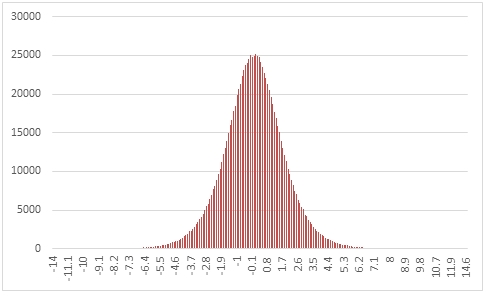SQL Server RANDLOGISTIC Function
Updated 2023-10-18 16:02:54.967000
Description
Use the table-valued function RANDLOGISTIC to generate a sequence of random numbers from a logistic distribution with parameters @Location and @Scale.
Syntax
SELECT * FROM [westclintech].[wct].[RANDLOGISTIC](
<@Rows, int,>
,<@Location, float,>
,<@Scale, float,>)
Arguments
@Rows
the number of rows to generate. @Rows must be of the type int or of a type that implicitly converts to int.
@Location
the location parameter. @Shape must be of the type float or of a type that implicitly converts to float.
@Scale
the scale parameter. @Scale must be of the type float or of a type that implicitly converts to float.
Return Type
table
{"columns": [{"field": "colName", "headerName": "Name", "header": "name"}, {"field": "colDatatype", "headerName": "Type", "header": "type"}, {"field": "colDesc", "headerName": "Description", "header": "description", "minWidth": 1000}], "rows": [{"id": "be81ba78-6963-40a6-9db3-3d8b6b2b15d0", "colName": "Seq", "colDatatype": "int", "colDesc": "A monotonically increasing sequence number"}, {"id": "99893ce9-75e1-41c2-8405-1a3cd694b703", "colName": "X", "colDatatype": "float", "colDesc": "The random variable"}]}
Remarks
@Scale must be greater than zero.
If @Shape is NULL then @Shape is set to 0.
If @Scale is NULL then @Scale is set to 1.
If @Rows is less than 1 then no rows are returned.
Examples
In this example we create a sequence of 1,000,000 random numbers rounded to one decimal place from the logistic distribution with @Location = 0 and @Scale =1, COUNT the results, and paste them into Excel, and graph them.
SELECT X,
COUNT(*) as [COUNT]
FROM
(
SELECT ROUND(X, 1) as X
FROM wct.RANDLOGISTIC( 1000000, --@Rows
0, --@Location
1 --@Scale
)
) n
GROUP BY X
ORDER BY X;
This produces the following result.

In this example we generate 1,000,000 random numbers from a logistic distribution with @Location of 60 and @Scale of 1.333333. We calculate the mean, standard deviation, skewness, and excess kurtosis from the resultant table and compare those values to the expected values for the distribution.
DECLARE @size as int = 1000000;
DECLARE @location as float = 60;
DECLARE @scale as float = 1.333333;
DECLARE @mean as float = @location;
DECLARE @var as float = POWER(@scale, 2) * POWER(PI(), 2) / 3e+00;
DECLARE @stdev as float = SQRT(@var);
DECLARE @skew as float = 0;
DECLARE @kurt as float = 1.2;
SELECT stat,
[RANDLOGISTIC],
[EXPECTED]
FROM
(
SELECT x.*
FROM
(
SELECT AVG(x) as mean_LOGISTIC,
STDEVP(x) as stdev_LOGISTIC,
wct.SKEWNESS_P(x) as skew_LOGISTIC,
wct.KURTOSIS_P(x) as kurt_LOGISTIC
FROM wct.RANDLOGISTIC(@size, @location, @scale)
) n
CROSS APPLY
(
VALUES
('RANDLOGISTIC', 'avg', mean_LOGISTIC),
('RANDLOGISTIC', 'stdev', stdev_LOGISTIC),
('RANDLOGISTIC', 'skew', skew_LOGISTIC),
('RANDLOGISTIC', 'kurt', kurt_LOGISTIC),
('EXPECTED', 'avg', @mean),
('EXPECTED', 'stdev', @stdev),
('EXPECTED', 'skew', @skew),
('EXPECTED', 'kurt', @kurt)
) x (fn_name, stat, val_stat)
) d
PIVOT
(
sum(val_stat)
FOR fn_name in ([RANDLOGISTIC], [EXPECTED])
) P;
This produces the following result (your result will be different).
{"columns":[{"field":"stat"},{"field":"RANDLOGISTIC","headerClass":"ag-right-aligned-header","cellClass":"ag-right-aligned-cell"},{"field":"EXPECTED","headerClass":"ag-right-aligned-header","cellClass":"ag-right-aligned-cell"}],"rows":[{"stat":"avg","RANDLOGISTIC":"59.9999110998668","EXPECTED":"60"},{"stat":"kurt","RANDLOGISTIC":"1.16521984825869","EXPECTED":"1.2"},{"stat":"skew","RANDLOGISTIC":"-0.000310984734915708","EXPECTED":"0"},{"stat":"stdev","RANDLOGISTIC":"2.41533527763239","EXPECTED":"2.4183985477125"}]}
See Also
LOGISTICINV - Calculate the inverse lower cumulative distribution of the logistic distribution.
RANDBETA - Random numbers from a beta distribution
RANDBINOM - Random numbers from a binomial distribution
RANDCAUCHY - Random numbers from a Cauchy distribution
RANDCHISQ - Random numbers from a chi-squared distribution
RANDEXP - Random numbers from an exponential distribution
RANDFDIST - Random numbers from an F-distribution
RANDGAMMA - Random numbers from a gamma distribution
RANDLAPLACE - Random numbers from a LaPlace distribution
RANDNORMAL - Random numbers from the normal distribution
RANDPOISSON - Random numbers from a Poisson distribution
RANDSNORMAL - Random numbers from the standard normal distribution